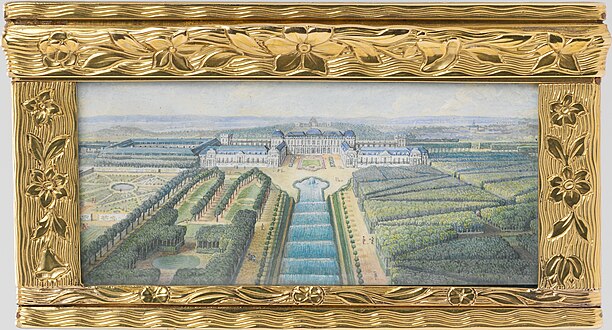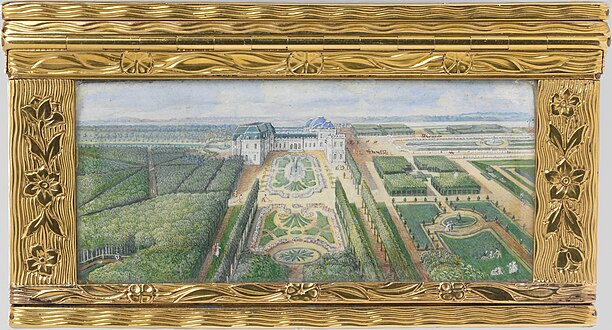Château de Chanteloup
| Château de Chanteloup | |
|---|---|
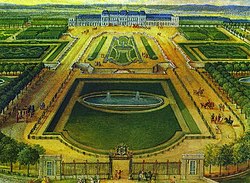 View from the north in 1767 | |
| General information | |
| Architectural style | Baroque and Neoclassical |
| Town or city | Amboise (Indre-et-Loire) |
| Country | France |
| Coordinates | 47°23′44″N 0°58′12″E / 47.39548°N 0.96988°E |
| Construction started | 1583 |
| Renovated | c. 1700, 1711, 1762 |
| Demolished | 1823 |
| Design and construction | |
| Architect(s) |
|
The Château de Chanteloup was an imposing 18th-century French
History
Origins
In the 16th century the site was nothing more than a
-
"General perspective view of the house, courtyard, service courtyard, gardens, woods, vineyards, and park of Chanteloup from the entrance side with the environs, all situated near Amboise, and view toward the Loire River" (1708)[5]
1708–1761: D'Aubigny
Creation of the château
On 22 February 1708, Louis Le Boultz sold the house and
D'Aubigny's focus in 1711, when construction began, was on Spain and the south. Robert de Cotte modified the central part, the
-
Plan of the premier étage (first floor), 1711 (Bibliothèque de l'Institut de France, Paris)
-
Plan of the deuxième étage (second floor), 1711 (Bibliothèque de l'Institut de France, Paris)
-
The Battle of Almança or The Battle of Villaviciosa, study by Henri de Favanne for the Grande Galerie (private collection)[10]
-
The Kingdoms of Valencia and Aragon Surrender to Philip V, King of Spain, by Henri de Favanne for the Grande Galerie (Palais des Beaux-Arts, Lille)
Creation of the French formal gardens
D'Aubigny also extended and enhanced the gardens and the park, which due to the terrain and the river were mostly to the south. The park was divided into numerous geometrically arranged groves of tall trees (
D'Aubigny died in the Château de Chanteloup in April 1732.[4] Saint-Simon, who died in 1755, described Chanteloup in the period after d'Aubigny's death, as "one of the most beautiful and singular places in all France, and the most superbly furnished."[12]
A plan of 1761 from the Municipal Library of
-
View from the south of the Château de Chanteloup in 1762, showing the Porte d'Espagne (Spanish Gate), painted byMusée des Beaux-Arts, Tours)
-
Detail from a plan of 1761 (north to the left), showing the French formal gardens (Bibliothèque Municipale, Tours)[14]
1761–1785: The Duke of Choiseul

Grand Park
The Marquise d'Armentières, a descendant of d'Aubigny, sold the château in 1761 to
Master plan
Choiseul engaged the architect
-
Master plan of the Château de Chanteloup of 1761, north at the top (Bibliothèque nationale de France)
North facade and entrance
In 1765, one of the additions actually executed was the extension of the north facade to the east and west with two 9-
-
View of the north facade with the colonnades and pavilions added by Louis-Denis Le Camus
Choiseul and Le Camus also shifted the main entrance to the north, allowing access from the road along the Loire by which carriages arrived from Amboise and Paris. The great entrance grille, the Grille Dorée (Golden Grille), was 12
-
View of the north entrance in 1767 (minitature painting byLouis-Nicolas van Blarenberghe for the Chanteloup gold snuffbox, Metropolitan Museum of Art)
-
View of the entrance courtyards and north facade (anonymous drawing with watercolor, Bibliothèque nationale de France)
Waterworks
The gardens of the Petit Parc (Small Park) to the south of the château were modified very little but there was a significant exception: a long terraced cascade running from the demi-lune parterre of the former Spanish Gate to a pièce d'eau just to the south of the cour d'honneur. The demi-lune parterre itself was transformed into a lake.[24] The cascade is depicted in two of Van Blarenberghe's snuffbox miniatures and in a 1768 painting by Jean-Pierre Houël, part of a series of six overdoors for the music room of the château, of which four survive.[25]
-
View to the south, showing the garden cascade, the half-moon lake, and the patte d'oie (miniature painting by Van Blarenberghe for the Chanteloup gold snuffbox, Metropolitan Museum of Art)
-
View of the south facade from the terraced garden cascade (overdoor of 1768 by Jean-Pierre Houël, Musée des Beaux-Arts, Tours)
Around 1770 another important water feature was added, a canal, leading to the south side of the demi-lune lake and aligned on the central axis of the château and the Grand Park. The canal is shown on a 1770 site plan attributed to Le Camus and is depicted in paintings by Louis-Nicolas Van Blarenberghe and Nicolas Perignon.[26] The demi-lune lake and the canal still exist, although the canal is filled-in and has become a lawn.[27]
-
Site plan attributed to Louis-Denis Le Camus, c. 1770 (collection of Thierry André)
-
The lake and canal of Chanteloup (painting attributed to Louis-Nicolas Van Blarenberghe,Musée du Louvre)
-
View of the canal and the patte d'oie (painting by Nicolas Perignon, private collection)
Colonnades on the cour d'honneur
Colonnades were an architectural feature that seemed to please Choiseul.[28] Le Camus used them again to fill in the setback of one toise (about two yards) of the south facade of the corps de logis (facing the cour d'honneur) with a seven-bay colonnaded portico, including a central avant-corps of three bays with a wider set of steps (perron) leading down to the courtyard.[29] The portico can be seen in a view of the south facade of the château taken from the middle of the cascade, painted around 1770 by Nicolas Perignon.[30] In the center of the corps de logis, Le Camus created a large entrance hall, through which one could pass to reach the courtyard on the south, the cour d'honneur. To the left of the entrance hall was a series of three large rooms, and to its right a large dining room with windows facing north, rather than the cour d'honneur as before.[31]
-
View of the south facade of the château from the middle of the cascade, showing the colonnaded portico topped with a balustraded terrace (painted c. 1770 by Nicolas Perignon)
-
View of the parterre of the cour d'honneur, the pièce d'eau, and the garden cascade taken from the terrace above the south portico (painted c. 1770 by Nicolas Perignon)
Le Camus later added colonnades to two new pavilions extending and terminating the south ends of the lateral wings flanking the cour d'honneur.
-
Plan of the ground floor of the Château de Chanteloup (north at the bottom) with the colonnades added by Louis-Denis Le Camus to the cour d'honneur[34]
-
View of the south (garden) facade with the colonnades and pavilions added by Le Camus (undated drawing from the Bibliothèque nationale de France)[35]
Jardin anglo-chinois and pagoda
In December 1770, Louis XV banished Choiseul from court and ordered him to retire to Chanteloup. Before returning to Paris in 1775, after the lifting of his exile by
-
Site plan of the Chanteloupjardins anglaisin 1775
-
View to the east with the Bathing Pavilion and the edge of the jardin anglo-chinois (painting by Louis-Nicolas Van Blarenberghe)
-
Elevation drawingof the pagoda
-
View of the pagoda (painting attributed to Louis-Nicolas Van Blarenberghe, Musée du Louvre)
-
View of the pagoda from the grand salon of the château (undated drawing from the Bibliothèque nationale de France)[38]
1785–1823: Decline and demolition
After Choiseul's death in 1785 the château was purchased by the Duke of Penthièvre, who added to the collection of paintings, most notably works by François Boucher. The French Revolution began a period of decline, the property becoming a public good in 1797 and suffering abandonment until 1802, when it was bought by the chemist-industrialist Jean-Antoine Chaptal.[39]
Chaptal, a rich man, was
In order to pay heavy debts owed by his son from investments in the
1823–present: Domaine de Chanteloup
Only some of the park, two pavilions, a semicircular ornamental pool, and a few other garden features survive,
-
Pagoda of Chanteloup as sketched by Bergeron in 1845
-
Pagoda of Chanteloup in 2007
-
Pagoda and a pavilion
Choiseul-Chanteloup snuffbox
The château and its gardens were depicted by
-
Choiseul-Chanteloup snuffbox (1767, Metropolitan Museum of Art)
-
Northern view of the château from the entrance screen, the "Grille Dorée"[47] (snuffbox top)
-
View of the garden facade from the south (snuffbox front)
-
View of the château from the east (snuffbox back)
-
View from the château toward the south, showing the site of the future Pagoda of Chanteloup (1775) in front of the semicircular lake (snuffbox bottom)
Notes
- ^ Watson 1966, p. 156.
- ^ Pagode de Chanteloup website.
- ^ Carré de Busserolle 1879, p. 110; André 1928, pp. 21–22; Chenu & Stainier 2014, p. 2.
- ^ a b Chenu & Stainier 2014, p. 2.
- ^ "Veüe generale en Perspective de la maison cour bassecour Jardins bois Vignes et parc de Chanteloup du costé de l'entrée avec les environs le tout Situé près Amboise et veüe sur la rivière de Loyre", Bibliothèque nationale de France.
- ^ Chenu & Stainier 2014, p. 2; "Chanteloup History", Chanteloup website; Neuman 1994, p. 229 note 4; Gallet 1995, p. 289–290.
- ^ André 1935, pp. 24–26.
- ^ Plan of the premier étage of the Château de Chanteloup Archived 2021-10-22 at the Wayback Machine. Bibliothèque de l'Institut de France, Paris. Digital copy from the website of the Agence Photo de la RMN.
- ^ Moreau 2008, p. 1.
- ^ Sotheby's 2007.
- ^ André 1935, p. 26; Moreau 2008, p. 3.
- ^ Saint-Simon 1857, p. 100.
- ^ MBA Tours 2007, p. 9; Grateau 2015, p. 70 (source of the reproduction); André 1935, p. 35 (garden plan drawn by André after the original); Watson 1966, p. 157 (style).
- ^ Reproduced by Grateau 2015, p. 70; also by Moreau 2008, p. 2.
- ^ Reproduced by Grateau 2015, p. 76; also by Moreau 2008, p. 3.
- ^ André 1935, p. 27; Watson 1966, p. 156.
- ^ Hoog 1996, p. 372.
- ^ MBA Tours 2007, p. 9; Moreau 2008, pp. 3–4; Watson 1966, p. 157.
- ^ Gallet 1995, p. 290.
- ^ a b c Grateau 2015, p. 84.
- ^ "[Plan du château et du parc de Chanteloup], 1761", Bibliothèque nationale de France, département Cartes et plans, GE A-1124 (RES).
- ^ André 1935, pp. 28–29; Watson 1966, p. 156; Grateau 2015, p. 84.
- ^ André 1935, pp. 28–29, 32–33; Moreau 2008, p. 5; Watson 1966, p. 156.
- ^ Grateau 2015, pp. 84, 86; Watson 1966, p. 157.
- ^ Conisbee 1996.
- ^ André 1935, after p. 28; Watson 1966, p. 157, plate 750; Grateau 2015, pp. 82, 89 (Van Blarenberghe), 96 (Perignon).
- ^ Moreau 2008, p. 5; Watson 1966, p. 157; Satellite view of the Canal de la Pagode at Zoom Earth.
- ^ According to André 1935, p. 28.
- ^ André 1935, pp. 28–29; Watson 1966, p. 156.
- ^ Grateau 2015, pp. 96–97.
- ^ André 1935, pp. 28–29.
- ^ The design of these pavilions differs from that shown on the master plan of 1761.
- ^ André 1935, pp. 28–29; Watson 1966, p. 156 (Italian paintings).
- ^ André 1928, Fig. 7 (after p. 44).
- ^ Published by André 1928, Fig. 8 (after p. 58).
- ^ Watson 1935, p. 157; MBA Tour 2007, p. 4.
- ^ Moreau 2008, p. 9.
- ^ Published by André 1928, Fig. 9 (after p. 58).
- ^ MBA Tours 2007, p. 2; Crosland 2008.
- ^ a b Crosland 2008.
- ^ MBA Tours 2007, p. 4; Crosland 2008.
- ^ MBA Tours 2007; Andreé 1935, p. 22 ("bande noire"); Gallet 1995, p. 290 (Enfantin); Watson 1966, p. 158 (Baudrand and Montesqiou).
- ^ Watson 1966, p. 158; Gallet 1995, p. 290.
- ^ Holmes 2008, pp. 124–125.
- ^ Base Mérimée: Domaine de Chanteloup, Ministère français de la Culture. (in French)
- The Metropolitan Museum of Artwebsite.
- ^ Today there is a street near this location, the Avenue de la Grille Dorée.
Bibliography
- André, R. Édouard (1928). "Le Domaine de Chanteloup", pp. 19–96, in Chanteloup by André Hallays, R. Édouard André, and Roland Engerand. Tours: Maison Alfred Mame et fils. OCLC 494077689.
- André, R. Édouard (1935). "Documents inédits sur l'histoire du château et des jardins de Chanteloup", pp. 31–35, in Bulletin de la Société de l'Histoire de l'Art Français, no. 1 (1 March 1935). ISSN 0301-4126.
- Carré de Busserrole, Jacques-Xavier (1879). Dictionnaire géographique historique et biographique d'Indre-et-Loire et de l'ancienne province de Touraine, volume 2. Tours: Imprimérie Rouillé-Ladevèze. Copy at Google Books.
- Chenu, Rachel; Stainier, Lauranne (2015). Les vases des jardins de Versailles à Chanteloup, Master Histoire de l'art, François Rabelais University, Tours. Online pdfat ash.univ-tours.fr.
- Conisbee, Philip (1996). "Hoüel, Jean-Pierre-Louis-Laurent", vol. 14, p. 799, in ISBN 9781884446009. Also at Oxford Art Online(subscription required).
- Crosland, M. P. (2008). "Chaptal, Jean Antoine", Complete Dictionary of Scientific Biography. Charles Scribner's Sons. Archived copy (13 December 2017) at the archive.org.
- Gallet, Michel (1995). Les Architectes parisiens du XVIIIe siècle. Paris: Mengès. ISBN 9782856203705.
- Grateau, Alexandre (2015). De la Pagode de Chanteloup à Chanteloup, travail personnel de fin d'études. Ècole nationale supérieure d'architecture et du Paysage de Bordeaux.
- Hoog, Simone (1996). "Versailles", vol. 32, pp. 369–374, in ISBN 9781884446009. Also at Oxford Art Online(subscription required).
- Holmes, Caroline (2008). Follies of Europe: Architectural Extravaganzas. Suffolk: Garden Art Press. ISBN 9781870673563.
- John, Richard (1996). "Le Camus, Louis-Denis", vol. 19, p. 26, in ISBN 9781884446009. Also at Oxford Art Online(subscription required).
- MBA Tours (2007). Chanteloup, un moment de grâce autour du duc de Choiseul, press release for the exhibition held from 7 April to 8 July 2007, Musée des Beaux-Arts, Tours. Online copy at the museum website.
- Moreau, Véronique (2008). “Les jardins du duc de Choiseul à Chanteloup”, Colloque l’Esprit des jardins : entre tradition et création, 5–6 September 2008, Conseil Général d'Indre-et-Loire. Online copy.
- Neuman, Robert (1994). Robert de Cotte and the Perfection of Architecture in Eighteenth-Century France. Chicago/London: The University of Chicago Press. ISBN 9780226574370.
- Saint-Simon, Louis de Rouvroy, duc de (1857). The Memoirs of the Duke of Saint-Simon on the Reign of Louis XIV and the Regency, translated and abridged from the French by Bayle St. John, volume 3. London: Chapman & Hall. Copy at Google Books.
- Sotheby's (2007). La bataille d’Almança or La bataille de Villaviciosa[permanent dead link], Sotheby's Old Master and 19th Century Drawings and Paintings, Paris, 19 June 2007.
- Watson, F. J. B. (1966). "Choiseul Boxes", pp. 141–158, reprint from Eighteenth Century Gold Boxes of Europe, edited by A. Kenneth Snowman. Boston Book and Art Shop. ISBN 9780571068005.


!["General perspective view of the house, courtyard, service courtyard, gardens, woods, vineyards, and park of Chanteloup from the entrance side with the environs, all situated near Amboise, and view toward the Loire River" (1708)[5]](http://upload.wikimedia.org/wikipedia/commons/thumb/f/f3/Ch%C3%A2teau_de_Chanteloup%2C_1708_perspective_view_%E2%80%93_Gallica_2007_%28composite%29.jpg/643px-Ch%C3%A2teau_de_Chanteloup%2C_1708_perspective_view_%E2%80%93_Gallica_2007_%28composite%29.jpg)

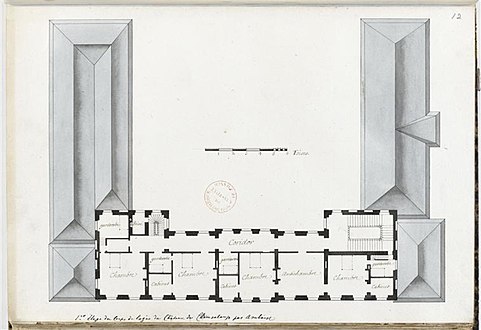
![The Battle of Almança or The Battle of Villaviciosa, study by Henri de Favanne for the Grande Galerie (private collection)[10]](http://upload.wikimedia.org/wikipedia/commons/thumb/e/ec/Henri_Antoine_de_Favanne._La_bataille_d%E2%80%99Alman%C3%A7a_ou_La_bataille_de_Villaviciosa_%28v._1714%29.jpg/535px-Henri_Antoine_de_Favanne._La_bataille_d%E2%80%99Alman%C3%A7a_ou_La_bataille_de_Villaviciosa_%28v._1714%29.jpg)


![Detail from a plan of 1761 (north to the left), showing the French formal gardens (Bibliothèque Municipale, Tours)[14]](http://upload.wikimedia.org/wikipedia/commons/thumb/e/e5/Chanteloup-_Plan_g%C3%A9om%C3%A9tral%2C_1761_%E2%80%93_Biblioth%C3%A8que_municipale_Tours_%E2%80%93_Grateaux_2015_p._70_%28detail%29.jpg/614px-Chanteloup-_Plan_g%C3%A9om%C3%A9tral%2C_1761_%E2%80%93_Biblioth%C3%A8que_municipale_Tours_%E2%80%93_Grateaux_2015_p._70_%28detail%29.jpg)




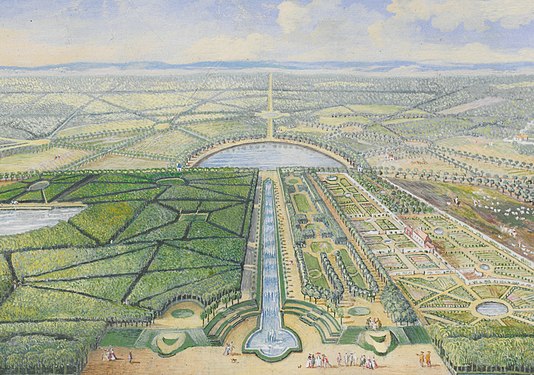






![Plan of the ground floor of the Château de Chanteloup (north at the bottom) with the colonnades added by Louis-Denis Le Camus to the cour d'honneur[34]](http://upload.wikimedia.org/wikipedia/commons/thumb/a/aa/Ch%C3%A2teau_de_Chanteloup%2C_floor_plan_by_Chateigner_%E2%80%93_Andr%C3%A9_1928%2C_after_p._44_%28Fig._7%29.jpg/291px-Ch%C3%A2teau_de_Chanteloup%2C_floor_plan_by_Chateigner_%E2%80%93_Andr%C3%A9_1928%2C_after_p._44_%28Fig._7%29.jpg)
![View of the south (garden) facade with the colonnades and pavilions added by Le Camus (undated drawing from the Bibliothèque nationale de France)[35]](http://upload.wikimedia.org/wikipedia/commons/thumb/b/bb/Ch%C3%A2teau_de_Chanteloup_%28Indre-et-Loire%29%2C_c%C3%B4t%C3%A9_du_jardin_%E2%80%93_Gallica_2007_%28adjusted%29.jpg/677px-Ch%C3%A2teau_de_Chanteloup_%28Indre-et-Loire%29%2C_c%C3%B4t%C3%A9_du_jardin_%E2%80%93_Gallica_2007_%28adjusted%29.jpg)


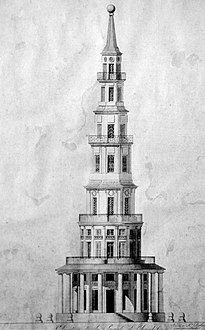

![View of the pagoda from the grand salon of the château (undated drawing from the Bibliothèque nationale de France)[38]](http://upload.wikimedia.org/wikipedia/commons/thumb/7/71/Vue_de_la_pagode_de_Chanteloup%2C_prise_du_grand_salon_du_ch%C3%A2teau_%E2%80%93_Gallica_2007_%28adjusted%29.jpg/536px-Vue_de_la_pagode_de_Chanteloup%2C_prise_du_grand_salon_du_ch%C3%A2teau_%E2%80%93_Gallica_2007_%28adjusted%29.jpg)
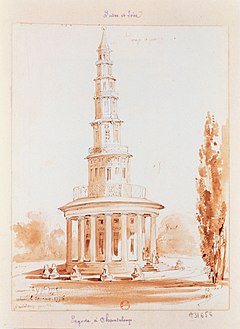



![Northern view of the château from the entrance screen, the "Grille Dorée"[47] (snuffbox top)](http://upload.wikimedia.org/wikipedia/commons/thumb/f/fa/Choiseul_box_%28Chanteloup%29_2_top_%22View_of_the_Ch%C3%A2teau_from_the_Entrance_Screen%22_Metropolitan_Museum_of_Art_DP170000_%28cropped%29.jpg/442px-Choiseul_box_%28Chanteloup%29_2_top_%22View_of_the_Ch%C3%A2teau_from_the_Entrance_Screen%22_Metropolitan_Museum_of_Art_DP170000_%28cropped%29.jpg)
